Canon IVSB2 of 1954-1956
A Description of Canon IVSB2 camera produced 1954-1956
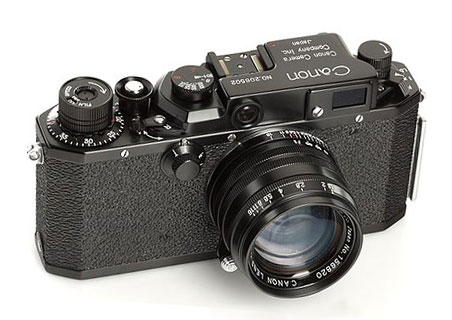
a Canon IVSB2 in the original optional black finish
Introduction of the Canon IVSB2 in 1954
Peter Dechert in his fine book Canon Rangefinders 1935-1968 wrote:
"It is ironic in a way that at the same time Leitz introduced the M3, exemplar of what we now perceive to be the final wave of rangefinder camera design, Canon were easing into production what surely was the finest bottom-loading 35mm rangefinder camera anyone has ever built." 1
The Canon IVSB2 was introduced to the market in March 1954. 4 Along with it were launched in the months which followed the Canon IIS2, IID2, and IIF2, described in other pages of this canonrangefinder.org site. The "2" of all of these models was intende to indicate that these were improvements of the IVSB, the IIS, IID and IIF. But they were more than that. These cameras included a number of important innovations:
- a new shutter was introduced. The split between high and low speed dials was a 1/30 second, and X flash synchronization was added to the fast dial with a synchronization speed of 1/45 second.
- the high shutter speeds of the new shutter could be set with the shutter cocked or uncocked.
- electronic strobe flash synchronization was improved
- the viewfinder and its eyepiece was improved for better visibility
- camera bodies were made more rugged.
The New Shutter of 1954
The Canon shutter mechanism introduced in 1954 retained the split high-speed dial on the camera top and slow speed dial on the camera front. Now, however, the split between dials was a 1/30 second. Also X flash synchronization was added to the fast dial with a red X between 30 and 60. The synchronization speed was about 1/45 second. This was a higher flash synchronization speed - previous synchronized Canons had a synchronization shutter speed of 1/15 second. With this new shutter, the synchronization being increased to 1/45 second reduced the possibility of 'ghosts' during exposure. This had previously occurred when a 'ghost' image was captured from available light during a slow shutter speed along with the flash image.
The new shutter also retained an X on the slow speed dial between 15 and 30 for synchonization with some strobe lights. Early electronic strobe lights sometimes had a delay in firing and this slower exposure time (about 1/20 second) allowed for such electronic strobes to be synchronized. The slow speed dial now had a lock to secure the dial while fast shutter speeds were being used.
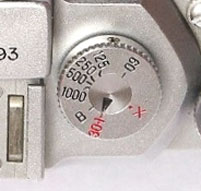
In the center of the fast speed dial, illustrated above, is an independently rotating shaft which points to the selected speed. This allowed the fast speed to be selected either with the shutter cocked or not cocked (wound). The fast speed dial collar was lifted and rotated to the desired setting and then re-seated.
The Canon IVSB2 sold for 85,000 yen with the 50mm f1.5 lens and for 74,500 yen with the superior 50mm f1.8 lens. 4 These lenses in a solid chromium finish were the standard lenses for these new rangefinders of 1954-1955.
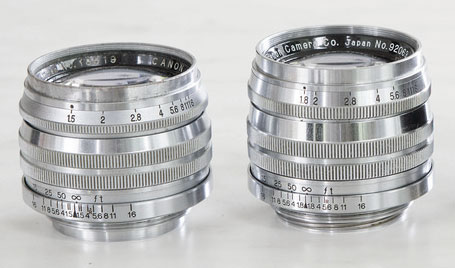
(l) the Canon 50mm f1.5 and (r) the Canon 50mm f1.8
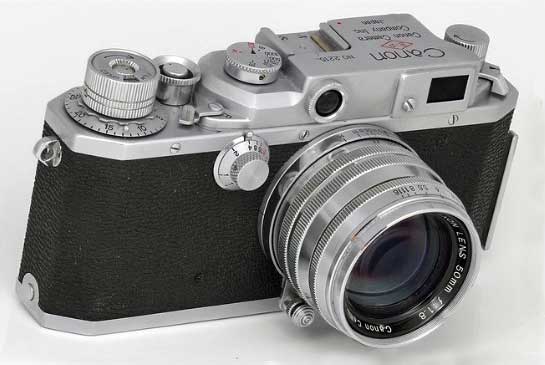
Canon IVSB2 with Canon 50mm f1.8
Canon Flash Units
By 1954, it became difficult to sell a 35mm camera without synchronization for flash. This was particularly the case for Canon's most important markets: first, the military PX stores selling to Allied military personnel in Japan and Korea, and second, the export market in North America and Europe. Stores in these export markets often would not agree to stock 35mm cameras lacking flash synchronization.
Canon developed a series of flash systems for its synchronized rangefinder cameras of the mid-1950s. "Systems" is an appropriate term, since the Canon flash units had a system of accessories to allow multiple battery units, cords for positioning flash units a distance from cameras, and units to test their flash units. The Canon Flash Unit B-1 is an example.
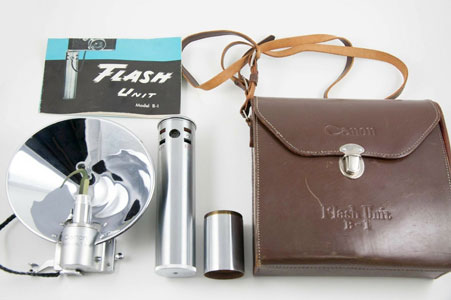
Canon Flash system B-I with accessories and case
The Canon Flash Model B-I included a battery unit which could be attached to the tripod socket of the IVSB2 (or other Canon rangefinder) with a wire going to the flash unit which could be placed in any location preferred by the photographer. There was also a battery extension unit which could be attached to the battery unit to extend battery life. All this in another of Canon's fine fitted leather cases.
Canon Flash system Model Y
With the solid bar attached to the side of Canon rangefinders, a flash unit could be slid into the flash bar, attaching the flash unit securely to the camera side.

Other camera manufacturers who offered flash synchronization, such as with the Minolta-35 Cameras, which were the first Japanese cameras to offer flash synchronization in March 1949 used a pin, and later coaxial connector. This had the advantage of compactness, but the Canon flash bar provided a solid and secure physical connection, as well as an electrical connection without wires. An example of this convenience can be seen with the Canon Flash Model Y.
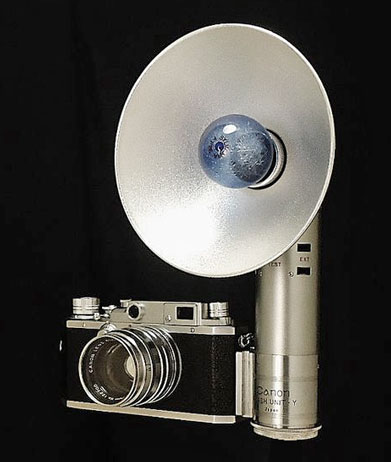
Canon Flash Model Y attached to a Canon IVSB body
The Canon IVSB2, as described above was one of the important achievements of Canon in the mid-1950s and with 16,800 units sold, primarily outside Japan, was also a commercial success. You can read about the other Canon modes of 1954 and 1955 by clicking on the links to the Canon IIS2, Canon IOID2, and Canon IIF2. be;pw
You can click on the links in the table below to consult other pages of the canonrangfinder.org site.
| Navigation: Click Below to Jump to Desired Subject Page | ||
|---|---|---|
| Canon Rangefinder Cameras - 1 | Canon Rangefinder Cameras - 2 | Canon Rangefinder Lenses |
| Canon S | Canon IVSB2 | Canon 19mm |
| Canon J | Canon IIS2, IID2, IIF2 | Canon 25mm |
| Canon NS | Canon VT, Canon L2 | Canon 28mm |
| Canon JS | Canon L1, L3 | Canon 35mm |
| Canon J-II | Canon VT Deluxe | Nikkor 50mm |
| Canon S-II | Canon VL, VL2 | Canon 50mm |
| Canon IIB | Canon VI-L, VI-T | Canon 85mm |
| Canon III, IIC, IV | Canon P | Canon 100mm |
| Canon IIIA, IVF, IVS | Canon 7 | Canon 135mm |
| Canon IIA, IID, IID1 | Canon 7s | Canon 200mm-1000mm |
| Canon IVSB | Minolta Rangefinders | Minolta Lenses |
| Canon IIF, IIS | Other Rangefinders | other M39 lenses |
| Go to canonrangefinder.com home page | ||
Any additions or corrections to these pages would be welcome simply by contacting this site as shown at the foot of this page .
Footnotes:
1 Dechert, Peter. Canon Rangefinder Cameras 1933-1968. Hove Collectors Books. West Sussex, United Kingdom. 1985. ISBN 0-906447-30-5.
Peter Dechert's book is the most important expert source of information regarding Canon Rangefinder Cameras.
2 Kitchingman, Peter. Canon M39 Rangefinder Lenses 1939-1971. A Collector's Guide. Published by Peter Kitchingman. Perth, Australia. 2008. ISBN 978-0-646-48144-9.
Peter Kitchingman's book is the definitive study of the more than three decades of M39 format camera lenses developed for Canon Rangefinder Cameras.
3 Nostalgic Canon Camera Book. 懐かしいキヤノン EI Publishing Co. Ltd. Tokyo, Japan. June 2003.
Peter Kitchingman's book is the definitive study of the more than three decades of M39 format camera lenses developed for Canon Rangefinder Cameras.
4 "Canon Camera Museum" history website. https://global.canon/en/c-museum/history/ published by Canon, Inc. accessed in 2019.
5 Rajner, Hans P. (author), John Wade (editor). Leica Copies. Classic Collections Publications. London, UK. ISBN 13: 9781874485056
Hans P. Rajner's book is an excellently detailed and carefully researched study of camera from around the world which used the Leica M39 lens mount and the same lens to film plane distance.
7 Dechert, Peter. Canon Single Lens Reflex Cameras 1959-1991. Historical Camera Publications. Yakima, Washington. 1992. ISBN 1-879561-04-2.
8 Tomlinson, Shawn M. The Film Photography Book. Lulu Pulbications. 2016. ISBN: 9781365263972
9 Sartorius., Ghester. Identifying Leica Lenses. Classic Camera 19. Tokyo, Japan. 2001. ISBN 4-257-12029-0
10 website http://www.nicovandijk.net/rflensmatrix.htm consulted 2019.
11 O'Reagan, Douglas M. Allied Exploitation of German Science after World War II. Johns Hopkins University Press. Baltimore, Maryland. 2019. ISBN 9781421428888
12 website www.canonrangefinder.servehttp.com consulted 2008.
13 Minolta expert Andrea Aprà has posted information on minoltarangefinders group and other groups and further detailed information by email. (thanks Andrea !)
14 website http://www.collection-appareils.fr/objectifs/ consulted 2019.
15 Small, Marc James. Non-Leitz Leica Thread-Mount Lenses. Wittig Books. Hückelhoven, Germany. 1997. ISBN 3-930359-47-2.
16 the Nikon Corporation website: https://imaging.nikon.com/history/ consulted 2019.
17 p 152. Ray, Sidney F. Photographic Lens ISBN 9780240510323
18 website http://www.rokkorfiles.com/Lens%20History.html accessed 2019
If you have any comments or questions about this Leopold Stokowski site, please e-mail me (Larry Huffman) at e-mail address: [email protected]